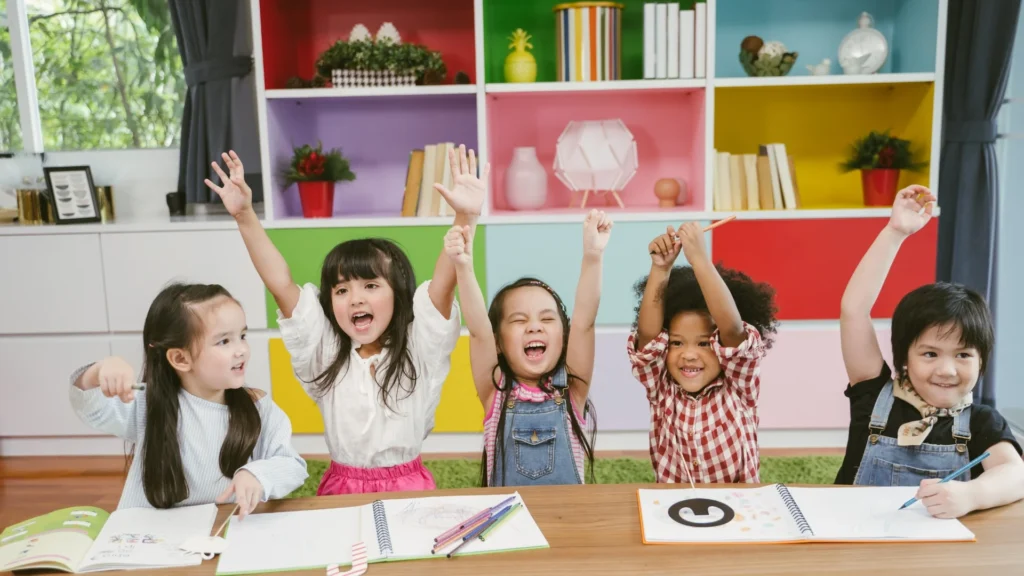Imagine a world where your child’s unique energy isn’t a hurdle, but a superpower. For parents of kids with ADHD, this isn’t just a dream – it’s a goal within reach. Learning how to build confidence in a child with ADHD can transform challenges into opportunities for growth and success.
ADHD isn’t just about fidgeting or daydreaming. It’s a complex condition that can make everyday tasks feel like climbing Mount Everest. But here’s the exciting part: with the right tools and strategies, your child can conquer those mountains and feel on top of the world.
In this guide, we will find out how to build confidence in a child with ADHD. We’ll explore practical, easy-to-implement techniques that can help boost your child’s self-esteem. From calming strategies to discipline approaches that actually work, we’ve got you covered. Ready to unlock your child’s potential and watch their confidence soar? Let’s dive in and discover how to turn ADHD challenges into stepping stones for success!
Understanding ADHD and Its Challenges

Before we find out how to build confidence in a child with ADHD, we need to first understand what ADHD is.
ADHD, or Attention-Deficit/Hyperactivity Disorder, is like having a brain that’s always in high gear. Kids with ADHD often struggle to focus, sit still, or control their impulses. It’s not that they won’t behave – it’s that their brains work differently.
Common challenges include:
- Difficulty paying attention: Imagine trying to listen to your teacher while a dozen TVs are playing different shows around you. That’s how distracting the world can be for a child with ADHD.
- Trouble completing tasks: Starting a project might be easy, but finishing it can feel like running a marathon.
- Impulsive behavior: Sometimes, thoughts turn into actions before the brain can say “wait a minute!”
- Struggles with organization: Keeping track of homework, toys, or daily routines can feel like solving a complex puzzle.
- Social difficulties: Understanding social cues or waiting for their turn in conversations can be challenging.
These challenges can chip away at a child’s self-esteem. They might feel “different” or “not good enough” compared to their peers. That’s why learning how to build confidence in a child with ADHD is crucial.
But here’s the good news: ADHD also comes with strengths. Many kids with ADHD are:
- Incredibly creative
- Bursting with energy
- Great at thinking outside the box
- Passionate about their interests
- Spontaneous and fun-loving
The key is to nurture these positives while supporting them through the tough stuff. With the right approach, kids with ADHD can thrive and feel great about themselves.
Strategies for Building Confidence

When it comes to building confidence in a child with ADHD, focusing on their strengths and interests is key. Here are some effective strategies:
Identify and Nurture Strengths
Children with ADHD often have unique talents. They might be incredibly creative, spontaneous, or have a knack for thinking outside the box. Pay attention to what your child excels at and provide opportunities to develop these skills further.
- Keep a “strength journal” to track positive moments
- Enroll in classes or workshops that align with their talents
- Share their accomplishments with family and friends
Encourage Special Interests
Many kids with ADHD have intense passions. Whether it’s dinosaurs, art, or coding, support these interests.
- Join clubs or after-school activities related to their favorite topics
- Plan family outings that cater to their interests
- Help them create projects or presentations about their passions
Set Achievable Goals
Break tasks into smaller, manageable steps. This allows your child to experience success more frequently, boosting their confidence.
- Use visual aids like checklists or sticker charts
- Celebrate each completed step, not just the final result
- Gradually increase the complexity of tasks as they build confidence
Positive Reinforcement
Praise effort, not just results. Celebrate small victories and progress to encourage persistence.
- Use specific praise: “I love how you kept trying even when it was tough”
- Create a “success board” to display achievements
- Implement a reward system for consistent effort
Foster Creativity
Provide outlets for creative expression. This could be through art, music, drama, or problem-solving activities.
- Set up a dedicated space for creative pursuits
- Encourage “out of the box” thinking in everyday situations
- Share and celebrate their creative works
Promote Physical Activity
Many children with ADHD thrive with movement. Encourage sports or active play to help channel their energy positively.
- Find sports or activities that match their interests and abilities
- Incorporate movement breaks during homework or chore time
- Use active games to teach concepts or practice skills
Remember, building confidence is a journey. By focusing on these strategies, you’re helping your child recognize and value their unique strengths. Consistency and patience are key – celebrate progress, no matter how small, and watch your child’s confidence grow!
Supporting Academic Success

When considering how to build confidence in a child with ADHD, academic success plays a crucial role. Here are some strategies to help your child thrive in school:
Create a Structured Environment:
- Establish a consistent daily routine for homework and study
- Use visual schedules and checklists to help your child stay organized
- Set up a quiet, clutter-free study space at home
Break Tasks into Manageable Chunks:
- Help your child divide large assignments into smaller, less overwhelming parts
- Use timers to create short work periods followed by brief breaks
Utilize Visual Aids:
- Encourage the use of color-coding for different subjects
- Create mind maps or diagrams to visualize complex information
Collaborate with Teachers:
- Regularly communicate with your child’s teachers about their progress
- Discuss potential accommodations, such as extra time for tests or a quiet testing area
Celebrate Small Victories:
- Acknowledge and praise effort, not just results
- Create a “success board” to display achievements, big and small
Incorporate Movement:
- Allow fidget toys or stress balls during study time
- Encourage short movement breaks between tasks
Teach Study Skills:
- Help your child develop note-taking techniques that work for them
- Practice active reading strategies, like highlighting and summarizing
Remember, the goal is to build confidence through success. By implementing these strategies, you’re not just supporting your child’s academic performance, but also fostering a sense of capability and self-assurance that will serve them well beyond the classroom.
Building Social Skills and Relationships

When considering how to build confidence in a child with ADHD, developing social skills and fostering positive relationships is crucial. Here are some strategies to help your child thrive socially:
Practice Social Scenarios:
- Role-play common social situations at home
- Teach and practice conversation starters
- Help your child understand body language and facial expressions
Encourage Structured Social Activities:
- Enroll your child in clubs or sports teams aligned with their interests
- Set up playdates in controlled environments
- Look for social skills groups specifically designed for children with ADHD
Teach Emotional Regulation:
- Help your child identify and name their emotions
- Practice calming techniques like deep breathing or counting to ten
- Create a “feelings chart” to track emotions throughout the day
Foster Empathy:
- Discuss characters’ feelings in books or movies
- Encourage your child to consider others’ perspectives
- Praise acts of kindness and consideration
Build Active Listening Skills:
- Play games that require turn-taking and listening
- Practice summarizing what others have said
- Teach the importance of eye contact and nodding
Address Social Challenges:
- Help your child identify specific social difficulties
- Work together to brainstorm solutions
- Celebrate small improvements in social interactions
Remember that building social skills takes time and practice. By consistently working on these areas, you’re not just helping your child make friends – you’re giving them tools to build confidence in social situations. This confidence can have a positive ripple effect across all areas of their life, boosting their overall self-esteem and happiness.
The Role of Parents and Caregivers

Parents and caregivers play a crucial role in building confidence in a child with ADHD. Your support and understanding can make a world of difference. Here are key ways you can help:
Be Your Child’s Biggest Cheerleader:
- Celebrate their strengths and unique qualities
- Offer specific praise for effort and improvement
- Create a “brag board” to showcase achievements
Establish Consistent Routines:
- Set up predictable daily schedules
- Use visual aids like charts or calendars
- Stick to routines as much as possible, even on weekends
Foster Open Communication:
- Create regular “check-in” times to talk
- Listen without judgment
- Encourage your child to express their feelings
Advocate for Your Child’s Needs:
- Work closely with teachers and healthcare providers
- Learn about ADHD and available support options
- Share effective strategies with others involved in your child’s care
Model Positive Behavior:
- Demonstrate patience and understanding
- Show how to handle frustration calmly
- Practice self-care and stress management
Create a Supportive Home Environment:
- Minimize distractions during homework time
- Organize spaces to reduce clutter and promote focus
- Establish clear, consistent rules and consequences
Remember, your attitude and approach can significantly impact your child’s self-esteem. By focusing on their strengths, maintaining a positive outlook, and providing unwavering support, you’re laying the foundation for your child’s confidence to flourish. Your love and understanding are powerful tools in helping your child navigate the challenges of ADHD and discover their unique potential.
Empower Your Child: Take Action Today

Learning how to build confidence in a child with ADHD is a journey filled with challenges and triumphs. Remember, your child’s ADHD doesn’t define them – it’s just one part of their unique personality. With the right support and strategies, your child can thrive and develop a strong sense of self-worth.
Your role in this process is crucial. Your love, patience, and understanding can make all the difference in your child’s life.
Remember, progress may be slow, but every small step counts. By consistently applying these strategies, you’re not just building your child’s confidence – you’re setting them up for a lifetime of success and happiness.
Don’t wait to make a difference. Start your journey to empower your child today. With your support and these tools, your child with ADHD can develop the confidence to tackle any challenge that comes their way.
Today we talked about the how to build confidence in a child with ADHD. Here are some other articles you might be interested in:
ADHD Paralysis: Here’s What you need to know
ADHD Comfort Food: Try These Now!
How to Build Confidence in a Child with ADHD
Postpartum ADHD: What you need to know



